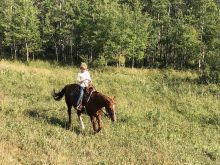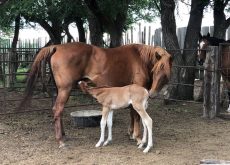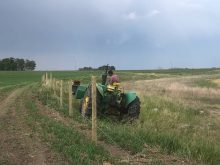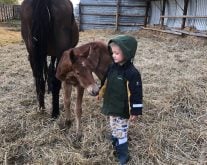The beginning of August found us baling buffer zones on the organic land, sloughs and ditches. The bales are few and far between this year.
On August 5, we set up the troughs on two of the pastures in Landis in preparation for the wells being dug. We purchased some large mining tires, and with a cement cap in the middle, they hold between 1,200 and 1,300 gallons. Being tires, they are not easily broken if the cows get to pushing and leaning into the troughs, they are not in danger of breaking if they freeze and they are not going to rust out.
Read Also

Gentle treatments for pain in the neck
Heading toward year-end, people unknowingly tense up against the cold and busyness, causing neck pain that can often be treated with appropriate support and gentle mobility, athletic therapist Kathlyn Hossack says.
Later that week, Wellen Boring came out from Saskatoon and bored the first well. The water has a low total dissolved solid count and it is an extraordinary producer at approximately 150 gallons per minute. The second well was dug the next day and it also has very good water and produces at a very good rate of 50 gallons per minute. We are thrilled will the water and it should make a very big difference for the cows and how we can manage our pastures in the future.
On August 12 harvest started up again as Gregory swathed John’s wheat on the home half. We started combining a couple of days later. On August 16,J ohn and I were combining wheat while Gregory was in Landis baling hay. We had every grain truck on the farm in the field and we filled everything just before the rain started. We hadn’t quite finished the field but Gregory did manage to get everything baled that had been cut.
It rained a little bit over the course of about 10 days. I think we ended up with over an inch and a half total. We would have liked the rain to have either come a month earlier or waited a while, but when we consider how dry everything was and how high the risk of fire was, we are not complaining about the rain. It really helped the pastures also. I think this is a case of where we get what we need, not necessarily what we want, even if it is hard to see it at the time.
While it was too wet to combine, we had lots of other projects on the go. Gregory and John set up a submersible pump at both of the pasture wells so that we can fill the water troughs using a generator as the power source until our solar pumps arrive and we can get them properly set up. We have to fill the troughs every four days or so depending on how hot the days are. It is still a chore that takes some time but at least it is not an everyday chore and the cows have started looking much better because of it. They do not have the runs and are fuller and more content.
August 30 Gregory and John started swathing again. As September arrived it was quite wet in the morning thanks to the heavy dew but that gave Gregory time to get the combines ready. In the afternoon they swathed a couple of more fields and then we finished combining the wheat field that we didn’t quite finish before the rain. John has been very happy with the yield on his wheat fields. Some of our fields will be quite a bit less than we are used to, while others are better than we expected. All in all, it’s not too bad considering all the challenges that the year has brought us.
















